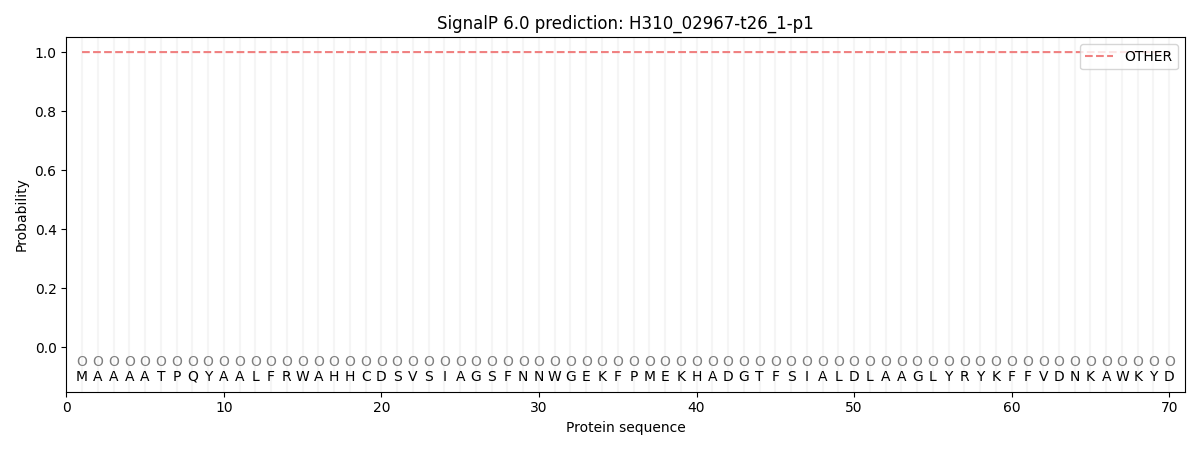You are browsing environment: FUNGIDB
CAZyme Information: H310_02967-t26_1-p1
You are here: Home > Sequence: H310_02967-t26_1-p1
Basic Information |
Genomic context |
Full Sequence |
Enzyme annotations |
CAZy signature domains |
CDD domains |
CAZyme hits |
PDB hits |
Swiss-Prot hits |
SignalP and Lipop annotations |
TMHMM annotations
Basic Information help
| Species | Aphanomyces invadans | |||||||||||
|---|---|---|---|---|---|---|---|---|---|---|---|---|
| Lineage | Oomycota; NA; ; Saprolegniaceae; Aphanomyces; Aphanomyces invadans | |||||||||||
| CAZyme ID | H310_02967-t26_1-p1 | |||||||||||
| CAZy Family | GT71 | |||||||||||
| CAZyme Description | hypothetical protein | |||||||||||
| CAZyme Property |
|
|||||||||||
| Genome Property |
|
|||||||||||
| Gene Location | ||||||||||||
CDD Domains download full data without filtering help
| Cdd ID | Domain | E-Value | qStart | qEnd | sStart | sEnd | Domain Description |
|---|---|---|---|---|---|---|---|
| 396253 | 6PF2K | 7.65e-67 | 297 | 513 | 7 | 223 | 6-phosphofructo-2-kinase. This enzyme occurs as a bifunctional enzyme with fructose-2,6-bisphosphatase. The bifunctional enzyme catalyzes both the synthesis and degradation of fructose-2,6-bisphosphate, a potent regulator of glycolysis. This enzyme contains a P-loop motif. |
| 140343 | PTZ00322 | 2.83e-45 | 280 | 693 | 187 | 622 | 6-phosphofructo-2-kinase/fructose-2,6-biphosphatase; Provisional |
| 395236 | His_Phos_1 | 1.60e-42 | 516 | 703 | 1 | 189 | Histidine phosphatase superfamily (branch 1). The histidine phosphatase superfamily is so named because catalysis centers on a conserved His residue that is transiently phosphorylated during the catalytic cycle. Other conserved residues contribute to a 'phosphate pocket' and interact with the phospho group of substrate before, during and after its transfer to the His residue. Structure and sequence analyses show that different families contribute different additional residues to the 'phosphate pocket' and, more surprisingly, differ in the position, in sequence and in three dimensions, of a catalytically essential acidic residue. The superfamily may be divided into two main branches. The larger branch 1 contains a wide variety of catalytic functions, the best known being fructose 2,6-bisphosphatase (found in a bifunctional protein with 2-phosphofructokinase) and cofactor-dependent phosphoglycerate mutase. The latter is an unusual example of a mutase activity in the superfamily: the vast majority of members appear to be phosphatases. The bacterial regulatory protein phosphatase SixA is also in branch 1 and has a minimal, and possible ancestral-like structure, lacking the large domain insertions that contribute to binding of small molecules in branch 1 members. |
| 223483 | PhoE | 1.01e-36 | 516 | 688 | 5 | 180 | Broad specificity phosphatase PhoE [Carbohydrate transport and metabolism]. |
| 214859 | PGAM | 1.29e-33 | 516 | 668 | 2 | 158 | Phosphoglycerate mutase family. Phosphoglycerate mutase (PGAM) and bisphosphoglycerate mutase (BPGM) are structurally related enzymes that catalyse reactions involving the transfer of phospho groups between the three carbon atoms of phosphoglycerate... Both enzymes can catalyse three different reactions with different specificities, the isomerization of 2-phosphoglycerate (2-PGA) to 3-phosphoglycerate (3-PGA) with 2,3-diphosphoglycerate (2,3-DPG) as the primer of the reaction, the synthesis of 2,3-DPG from 1,3-DPG with 3-PGA as a primer and the degradation of 2,3-DPG to 3-PGA (phosphatase activity). In mammals, PGAM is a dimeric protein with two isoforms, the M (muscle) and B (brain) forms. In yeast, PGAM is a tetrameric protein. |
CAZyme Hits help
| Hit ID | E-Value | Query Start | Query End | Hit Start | Hit End |
|---|---|---|---|---|---|
| 6.57e-256 | 9 | 708 | 44 | 731 | |
| 7.66e-93 | 303 | 693 | 397 | 783 | |
| 1.27e-11 | 9 | 94 | 9 | 98 | |
| 1.30e-10 | 20 | 93 | 28 | 103 | |
| 9.64e-10 | 13 | 95 | 316 | 397 |
PDB Hits download full data without filtering help
| Hit ID | E-Value | Query Start | Query End | Hit Start | Hit End | Description |
|---|---|---|---|---|---|---|
| 2.11e-108 | 305 | 700 | 18 | 408 | Human PFKFB3 in complex with a N-Aryl 6-Aminoquinoxaline inhibitor 6 [Homo sapiens] |
|
| 2.11e-108 | 305 | 700 | 19 | 409 | Human PFKFB3 in complex with a N-Aryl 6-Aminoquinoxaline inhibitor 4 [Homo sapiens] |
|
| 2.18e-108 | 305 | 700 | 19 | 409 | Human PFKFB3 in complex with a N-Aryl 6-Aminoquinoxaline inhibitor 5 [Homo sapiens] |
|
| 2.32e-108 | 305 | 700 | 21 | 411 | Human PFKFB3 in complex with a N-Aryl 6-Aminoquinoxaline inhibitor 7 [Homo sapiens] |
|
| 4.07e-108 | 305 | 700 | 37 | 427 | human PFKFB3 in complex with a pyrrolopyrimidone compound [Homo sapiens],4D4K_A human PFKFB3 in complex with a pyrrolopyrimidone compound [Homo sapiens],4D4L_A human PFKFB3 in complex with a pyrrolopyrimidone compound [Homo sapiens],4D4M_A human PFKFB3 in complex with a pyrrolopyrimidone compound [Homo sapiens] |
Swiss-Prot Hits download full data without filtering help
| Hit ID | E-Value | Query Start | Query End | Hit Start | Hit End | Description |
|---|---|---|---|---|---|---|
| 3.26e-107 | 305 | 700 | 37 | 427 | 6-phosphofructo-2-kinase/fructose-2,6-bisphosphatase 3 OS=Rattus norvegicus OX=10116 GN=Pfkfb3 PE=2 SV=1 |
|
| 1.50e-106 | 305 | 700 | 37 | 427 | 6-phosphofructo-2-kinase/fructose-2,6-bisphosphatase 3 OS=Pongo abelii OX=9601 GN=PFKFB3 PE=2 SV=2 |
|
| 1.80e-106 | 305 | 700 | 37 | 427 | 6-phosphofructo-2-kinase/fructose-2,6-bisphosphatase 3 OS=Homo sapiens OX=9606 GN=PFKFB3 PE=1 SV=1 |
|
| 8.17e-106 | 305 | 701 | 31 | 429 | 6-phosphofructo-2-kinase/fructose-2,6-bisphosphatase OS=Caenorhabditis elegans OX=6239 GN=pfkb-1.2 PE=3 SV=2 |
|
| 1.22e-105 | 305 | 701 | 42 | 432 | 6-phosphofructo-2-kinase/fructose-2,6-bisphosphatase OS=Gallus gallus OX=9031 PE=2 SV=2 |
SignalP and Lipop Annotations help
This protein is predicted as OTHER

| Other | SP_Sec_SPI | CS Position |
|---|---|---|
| 1.000052 | 0.000000 |
